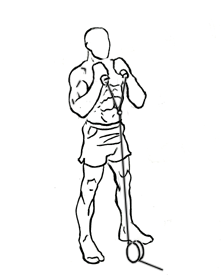Last Updated on September 30, 2022
Building well-defined biceps isn’t just about lifting heavy weights; it’s about executing exercises that maximize muscle engagement and growth. One such effective movement is the Hammer Curls with Rope and Cable. Unlike traditional dumbbell hammer curls, using a rope on a cable machine allows you to isolate the biceps while maintaining consistent tension throughout the movement, which is ideal for muscle development and definition. Whether you’re a beginner or an experienced lifter, this exercise can be an excellent addition to your arm workout routine.
Why Hammer Curls with Rope and Cable Are Effective
The Hammer Curls is a classic exercise that targets the brachialis (the muscle underneath the biceps) and the brachioradialis (a part of the forearm). Incorporating the rope and cable machine brings several benefits:
- Constant Tension: The cable provides resistance throughout the entire range of motion, unlike free weights, which only challenge the muscles at certain points.
- Isolation of Biceps: The rope attachment allows for a close grip, enhancing the focus on the biceps while minimizing involvement from other muscle groups like the shoulders.
- Stabilization: Using the cable machine helps you maintain a stable position, encouraging proper form and reducing the risk of swinging or cheating with your hips and back.
- Versatility: Cables and ropes allow for slight adjustments in grip and stance, making the exercise suitable for all experience levels.
Incorporating this exercise, you not only build strength but also work towards developing fuller, thicker arms that enhance your upper body aesthetics.
Step-by-Step Guide to Performing Hammer Curls with Rope and Cable
To execute this exercise correctly, follow these steps precisely. Proper form ensures that you engage the target muscles effectively while minimizing injury risk.
- Set Up the Equipment:
- Attach a rope to the low cable pulley on the machine. Make sure it is securely fastened to prevent accidents during the exercise.
- Adjust the weight stack to a manageable load, especially if you are new to this exercise. Start light and gradually increase the weight as you master the technique.
- Assume the Starting Position:
- Stand upright with your feet shoulder-width apart for a stable base. Slightly bend your knees to help absorb any motion and maintain balance.
- Draw your abs in to engage your core, which helps stabilize your torso during the movement. This engagement prevents unnecessary movement from your hips or lower back.
- Grip the Rope Correctly:
- Grasp the rope with an underhand grip (palms facing each other or facing up) while keeping your elbows close to your sides. Your hands should be close together, maintaining tension in your arms even in the starting position.
- Execute the Curl:
- Slowly lower your arms until they are fully extended and the rope is just above your thighs. Keep your elbows tucked at your sides throughout the movement—this is crucial for isolating the biceps.
- Bending only at your elbows, lift the rope towards your upper chest. Focus on squeezing your biceps at the top of the movement. Hold this position for a brief moment to enhance muscle activation.
- Return to the Starting Position:
- After a brief pause, slowly lower the rope back to the starting position while maintaining control. Avoid dropping the weight too quickly, as the eccentric (lowering) part of the movement is equally important for muscle growth.
Tips for Optimal Performance
To make the most out of this exercise, keep the following tips in mind:
- Focus on Form: Avoid swinging your hips or using your back to lift the weight. The movement should come exclusively from your arms. Swinging reduces the effectiveness of the exercise and increases the risk of injury.
- Breathe Properly: Inhale as you lower the weight and exhale as you lift. Proper breathing helps maintain stability and ensures oxygen flow, which is vital for performance and muscle endurance.
- Control the Movement: The cable machine’s resistance can be challenging to control if you rush through the reps. Aim for a slow and steady tempo—approximately 2-3 seconds up and 2-3 seconds down.
Common Mistakes and How to Avoid Them
Even though the Hammer Curl with Rope and Cable is straightforward, there are common mistakes that lifters make. Here’s how to correct them:
- Using Too Much Weight:
- Overloading the weight stack might force you to use momentum or swing your body, which takes the focus off the biceps. Always prioritize proper form over heavier weights.
- Allowing Elbows to Flare Out:
- Keep your elbows pinned to your sides. If they flare out, it shifts the workload away from your biceps and may involve your shoulders, reducing the exercise’s effectiveness.
- Swinging the Rope:
- Maintain a steady, controlled motion. Swinging the rope diminishes muscle engagement and may cause strain on your lower back.
- Rushing Through Reps:
- Avoid fast, jerky movements. Instead, perform each rep with a controlled tempo to maximize muscle engagement and hypertrophy.
Variations and Progressions
The Hammer Curls with Rope and Cable is versatile, and you can tweak it slightly to target different parts of your biceps or challenge yourself further:
- Single-Arm Rope Hammer Curl:
- This variation allows you to focus on one arm at a time, helping to correct any strength imbalances between your arms. It also provides a greater range of motion, leading to improved muscle activation.
- Overhead Rope Curl:
- Adjust the cable machine to a high pulley and perform the curl while standing. This variation targets the long head of the biceps differently, emphasizing the peak of the muscle.
- Seated Rope Hammer Curl:
- Sitting down while performing this exercise removes any possibility of using your back or lower body for momentum, allowing for maximum isolation of the biceps.
- Rope Curl with Supination:
- As you curl the rope upward, rotate your wrists so that your palms face your body at the top of the movement. This adds an additional element of rotation, which engages the brachialis and enhances the shape of the biceps.
Benefits of Hammer Curls with Rope and Cable
Adding this exercise to your routine comes with multiple benefits:
- Muscle Definition and Growth: By isolating the biceps and maintaining constant tension, this exercise encourages muscle hypertrophy (growth). The cable’s continuous resistance is key in building defined, strong arms.
- Improved Arm Strength: Consistent practice not only improves muscle size but also increases strength, which is beneficial for compound lifts like rows and bench presses.
- Enhanced Grip Strength: The rope attachment challenges your grip, indirectly strengthening your forearms—a critical component for exercises like deadlifts or pull-ups.
- Perfect for All Levels: This exercise is great for beginners because it teaches proper form while keeping the movement controlled and isolated. For advanced lifters, it remains effective as a finishing move after heavier compound exercises.
Incorporating Hammer Curls into Your Workout Routine
To maximize your bicep development, it’s crucial to integrate Hammer Curls with Rope and Cable strategically into your workout:
- As a Warm-Up: Begin your arm workout with light hammer curls to engage the biceps and prepare them for heavier lifts.
- Part of a Superset: Combine hammer curls with other bicep exercises like concentration curls or preacher curls to fully exhaust the muscles and promote growth.
- As a Finisher: Perform high-rep hammer curls at the end of your workout to achieve a muscle pump, increasing blood flow and nutrients to the area for recovery and growth.
Frequently Asked Questions
1. How many sets and reps should I perform?
- Beginners can start with 3 sets of 12-15 reps using a moderate weight. Advanced lifters can increase the weight and perform 4 sets of 8-10 reps for added intensity.
2. Can I perform this exercise at home?
- While a cable machine is typically available in gyms, home cable setups or resistance bands with a door anchor can replicate a similar movement pattern.
3. How do I know if I’m using the right weight?
- The ideal weight allows you to complete the reps with good form. If you find yourself struggling to finish a set without swinging or losing control, lower the weight.
The Hammer Curls with Rope and Cable is a versatile and effective exercise for anyone looking to develop well-rounded and strong biceps. With its ability to isolate the biceps while maintaining tension through a full range of motion, this exercise should be a staple in your arm workouts. Remember, form is key—keep your movements controlled, your elbows steady, and your core engaged. Whether you’re a beginner or advanced, incorporating this exercise will bring noticeable results over time.








